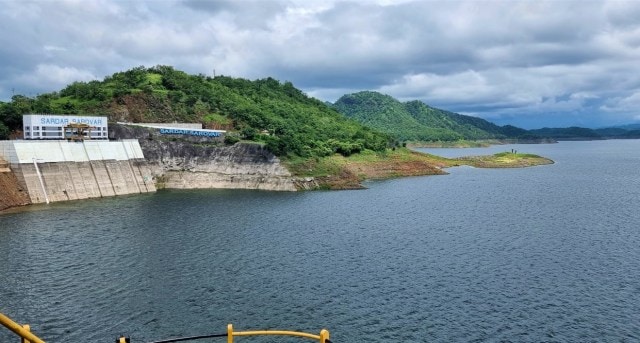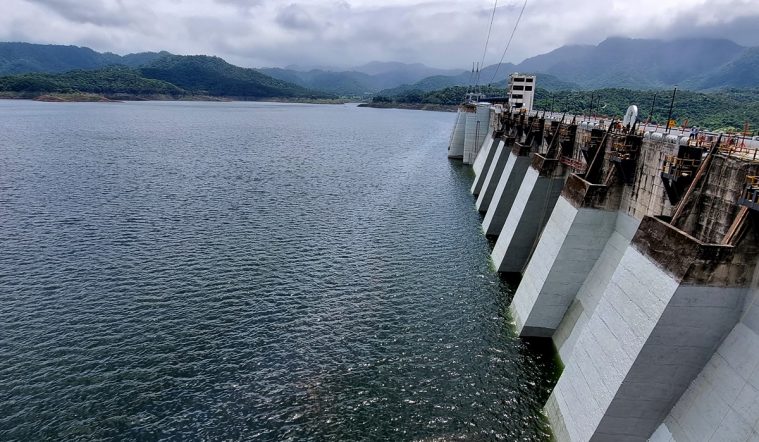50 % rainfall deficit in Narmada basin to affect state’s water share
While the Sardar Sarovar Narmada Nigam Ltd (SSNNL) is now preserving the water to raise the level in the basin, following heavy rainfall in Saurashtra and intermittent rainfall in Central Gujarat, the shortfall in the basin will hit the party states sharing the water when the allocation is calculated at the end of the monsoon in November this year.
 Water level in the Sardar sarovar dam in Narmada was at 120.45 metres as of September 14. (Express photo/ Bhupendra Rana)
Water level in the Sardar sarovar dam in Narmada was at 120.45 metres as of September 14. (Express photo/ Bhupendra Rana)The rainfall deficit in the Narmada basin, a major part of which is located in Madhya Pradesh, has impeded the flow of water into the Sardar Sarovar Project (SSP) in Narmada district of Gujarat, which is the lifeline of water supply in the state. Until September 14 this year, the Narmada basin has recorded only about 50 per cent of the rainfall it received in 2019-20 and 2020-21.
While the Sardar Sarovar Narmada Nigam Ltd (SSNNL) is now preserving the water to raise the level in the basin, following heavy rainfall in Saurashtra and intermittent rainfall in Central Gujarat, the shortfall in the basin will hit the party states sharing the water when the allocation is calculated at the end of the monsoon in November this year.
With the water level at 120.45 metres as of September 14, the SSP is currently receiving an average inflow of about 5,000 cusecs from upstream in Madhya Pradesh and has an outflow of about 1,500 cusecs from the Canal Head Power House (CHPH), which has one of its five 50W turbines running to generate 0.25 Million Units of hydropower — just the amount needed to
provide domestic water supply to dependent local bodies.
In a normal monsoon year, the inflow into SSP from MP at this time would run into lakhs of cusecs. The NCA computes the utilisable flow at different zones of the Narmada Basin at Bargi, Barmanghat, Hoshangabad, ISP, Maheshwar and Sardar Sarovar on the basis of observed flow, upstream utilizations for different uses, change in live storage during the water year and carryover storage available at the beginning of the water year. Until September 14 this year, the Narmada basin has recorded only about 50 per cent of the rainfall it received in 2019-20 and 2020-21.
The rain station of Bargi has so far received 318.8 mm of rainfall while Barmanghat has received 662.2mm, Hoshangabad has received 705mm, ISP has received 574.6, Maheshwar has received 388 mm and Sardar Sarovar has received 564.6mm as of September 14, this year. Until September 14 in 2020, the basin had recorded heavy rainfall at Bargi (644.2mm), Barmanghat (730.4mm), Hoshangabad (1391mm), ISP (625.4mm), Maheshwar (780.6mm) and Sardar Sarovar (968.5mm). Similarly the Omkareshwar Dam (OSP), which also releases water to Sardar Sarovar after generation of hydropower, has received 593.6mm rainfall respectively until September 14 this year. On September 14, 2020, OSP had recorded 985mm rainfall for the season.
 The Sardar sarovar dam in Kevadia in Narmada district is facing a low level of reservoir at 120.4 metres due to the deficit rainfall in Madhya Pradesh. (Express photo)
The Sardar sarovar dam in Kevadia in Narmada district is facing a low level of reservoir at 120.4 metres due to the deficit rainfall in Madhya Pradesh. (Express photo)
The SSP, which touched the Full Reservoir Level (FRL) of 138.68 metres for the second consecutive year in 2020, now has a live storage of 1,300 Million Cubic Metres (MCM). Both the Indirasagar (ISP) and Omkareshwar (OSP) dams in Madhya Pradesh that release a majority of water to SSP have also not been able to reach the FRL this year.
The filling up of SSP depends largely on the releases from Madhya Pradesh along with the intermediate catchment flow, the annual report of 2018-19 of the Narmada Control Authority (NCA) states. “The Indira Sagar Project being the mother reservoir, should be operated in such a way so as to impound water gradually to its FRL of 262.13 metres by regulating release to SSP. Since the requirements of Sardar Sarovar have to be met by MP releases and inflow from the intermediate catchment… releases from Omkareshwar will be considered as ex-MP releases until Maheshwar project is completed,” it says.
But the data of the Hydrology Directorate indicates that the 36 rain gauge stations of the Narmada basin located in Madhya Pradesh have received only intermittent rainfall in September after a severe dry spell since August 5.
The Sardar Sarovar Reservoir Regulation Committee (SSRRC) facilitates the allocation of available water for River Bed Power House (RBPH) after fulfilling various categories of demands such as irrigation requirements of Gujarat and Rajasthan, evaporation losses and environmental flow requirements.
Officials of SSNNL say that the NCA committee will allocate the share of the basin to the partner states in November after reviewing the utilisable water when monsoon season ends in October.
The annual report of the NCA states that for the year 2017-18, instead of the 28 Million Acre Feet (MAF) capacity of the basin, the available water in the basin was 15.62 MAF (19,264 MCM). During the deficit monsoon in 2017, Gujarat had to draw water from the dead storage of Sardar Sarovar, below the 110-metre mark. In 2018 also to manage the deficit from the 2017 rains, the dead storage was used.







